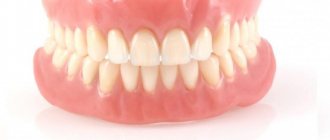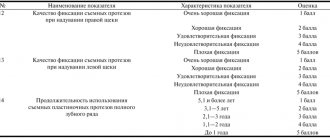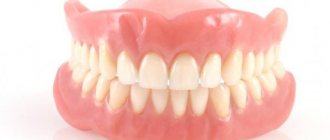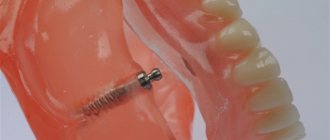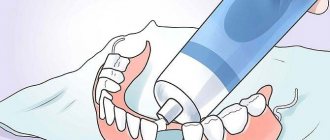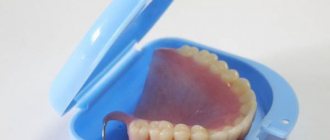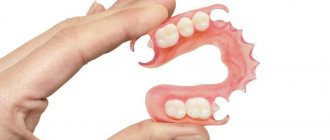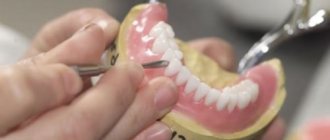What is a nylon prosthesis
Removable nylon dentures are soft orthopedic structures made of a pink, gum-colored nylon base with invisible clasps that hold it in the mouth. The fixation is on the adjacent teeth; the hooks wrap around the supports, keeping the prosthesis stationary on the jaw. Artificial crowns are placed on an elastic frame.
A person can take off and put on a nylon prosthesis without assistance. They are used in dentistry as a temporary solution during implantation (during the process of osseointegration) or as a permanent prosthesis according to indications.
Nylon is a polymer that has the quality of flexibility, and under certain conditions, in the patient’s mouth, softness increases. As a denture material, it has come as an alternative to dental acrylic, to which some people are allergic.
Partial nylon prosthesis RUR 40,000. for all!
The price includes: diagnostics, impressions, manufacturing, installation, fitting and 1 year warranty! Complete denture Akrifri 1 jaw - 47,000 rub.!
Stages of manufacturing a flexible prosthesis
To create nylon dentures, you must first treat the teeth, perform removal according to indications, and then proceed to the following steps:
- taking impressions of jaws in a clinical setting;
- plaster models are made in the laboratory;
- a wax prototype of the prosthesis is cast, tried on, and finalized;
- a nylon final version is created, matched to the color of the gum. The equipment used is a heat press, in which polymer granules are melted and an individual mold is poured in a liquid state. After hardening, the structure is polished.
Clasps are a continuation of nylon dentures and are therefore completely invisible on the jaw even when smiling and talking.
Types of prostheses
Dentures for the front teeth can be:
- Temporary. They are installed for a certain period of time, for example, when a tooth has been removed before implantation and it is necessary to wait for the production of a permanent prosthesis. Typically, temporary prostheses are low cost and last no more than two months.
In addition to the aesthetic function, temporary dentures perform a number of other functions:
- Restore the chewing function of a lost tooth.
- Prevents displacement of adjacent units, keeping the bite in order.
- Provide protection to the mucous membrane from damage and irritation.
Temporary dentures can be of the following types:
- Butterflies (immediate prostheses). They are attached using clasps, which are made of the same material as the base. For butterflies, a material such as nylon is usually used. It is very flexible and transparent, so it is practically invisible in the oral cavity.
- Crowns and bridges made of inexpensive plastic. Relevant during the production of permanent dentures before implantation. They can last up to six months with proper care.
- Permanent. Installed for a long time. They are made from high quality materials, the service life of which can exceed 20 years.
- Removable. Removable dentures are rarely installed on the front teeth, for example, in cases where there is no possibility of implantation or when the patient has completely missing teeth in a row.
Removable structures imply the possibility of their independent removal and installation in the oral cavity. The choice of denture material depends on the number of teeth that need to be restored, the condition of the patient’s bone tissue, his financial capabilities and other factors. Removable dentures can be made from various materials:
- Made from acrylic plastic. In this case, a hard plate is made that is attached to the palate due to the suction effect.
- Nylon dentures. The base of these structures is made of flexible, elastic nylon. Fixation is carried out by suction or using special glue.
Experts do not recommend installing removable dentures as permanent ones. This is due to the fact that there are difficulties in fixation, as a result of which the load on the jaw is distributed unevenly. This is especially evident when using nylon structures due to their high elasticity.
If the choice is made in favor of removable structures, then it is worth implanting support units to which the prostheses will be attached.
- Fixed. These are the majority of dentures designed for the front teeth. They can only be removed using special tools.
- Clasp dentures. Used when several front teeth are missing. These structures got their name due to the presence of a clasp - a metal arch on which the base of the prosthesis and crowns are fixed. The clasp is installed on supporting teeth or implants. Clasp dentures are an excellent choice for partial loss of teeth or if implantation is possible. Advantages of clasp dentures:
- Securely fixed in the oral cavity.
- Distribute the chewing load evenly.
- They provide aesthetics to your smile if they are made of high quality.
Indications for installation
Indications for removable nylon dentures can be:
- loss of one or more teeth in a row;
- scattered defect;
- absence of all teeth;
- allergy to metal, acrylic;
- if you do not want to grind the supporting teeth for dentures, for example, clasp ones with locks;
- periodontal disease of 1st and 2nd degrees to keep teeth in place (but 3.4 degrees will already be a contraindication);
- patient refusal or medical contraindications to implantation;
- childhood, if necessary, hide early tooth loss;
- as a temporary solution for implantation with delayed loading.
Sometimes nylon dentures can be installed to treat bruxism, involuntary grinding in the mouth, which damages tooth enamel and increases wear. And also for athletes and people involved in traumatic sports, a flexible design is the best option, better than acrylic, which can easily break in case of injury.
Solution
In many cases, the doctor can immediately determine that the patient’s removable denture will not hold. Then they choose another type of fastening - non-removable or conditionally removable (removable only by the dentist). This could be, for example, a bridge.
If you still choose a removable prosthesis, since there are contraindications for a fixed prosthesis, then another option is needed.
One of the methods
get rid of the problem - fastening with adhesive gel. The most popular of them is “Korega”. It will relieve the fear of the prosthesis falling out and the constant psychological discomfort associated with it. But it can also bring some inconvenience. For example, the need to periodically remove and apply gel. This will take time. Also, some people find it unpleasant to have a sticky substance in their mouth. But you can get used to it over time. Although rare, allergic reactions do occur. This is a complete contraindication to the use of the gel.
Second exit
– relining of the prosthesis. Over time, the bone tissue underneath the gum atrophies. Therefore, the structure does not fit so tightly. The denture must be sent to a dental laboratory for alteration. Then it will begin to stand normally in the mouth again without falling out.
Another radical solution
– implantation of two or more implants with ball heads. They fix the prosthesis, but at the same time it remains removable. This option allows you to forget about the artificial jaw falling out of your mouth. In this case, there will be no discomfort associated with the use of the adhesive gel. You won't have to spread it on your gums every time and add it throughout the day. There will be no need to experience discomfort due to the presence of a sticky substance in your mouth.
Contraindications
What may be a contraindication to a nylon prosthesis in dentistry:
- periodontal diseases (grade 3-4 periodontal disease), loose teeth, their displacement;
- recession;
- the height of the supporting teeth is not enough, the clasps will not be able to securely fasten;
- inflammatory processes of the mucous membrane and gums;
- tooth mobility;
- significant bone atrophy.
It is necessary to have healthy teeth on both sides of the prosthesis as supports for clasp fixation.
An alternative solution is implantation.
Any model of removable denture is not able to stop the process of bone tissue atrophy, which inevitably follows tooth extraction. The only option that can protect against atrophy is dental implantation, which allows you to preserve the existing volume of bone tissue. Using this technique, you can restore not only the crowns, but also the roots of the teeth, as well as the full functioning of the jaw system.
Video review from a patient about lower jaw implantation after long-term wearing of a removable denture
Varieties
There are:
- mini dentures for 1-2 teeth;
- partial (in the absence of three or more teeth);
- complete (replacing the dentition of the entire jaw).
Many people mistakenly believe that all flexible prostheses are nylon. This is wrong. They are very similar to the touch and in some characteristics. However, they should be considered separately.
Quadrotti prosthesis
A special modern type of prosthesis, which stands somewhere between clasp and nylon. It is more durable than the latter, has a little flexibility, and the fasteners are also not visible, unlike the clasp design, where, perhaps, this is the only drawback. The material of manufacture is monomer-free plastic.
Immediate prosthesis “butterfly”.
This is just a type of nylon prosthesis. It is used in cases where one, or less often, two teeth are missing. Small design, good replacement for a lost dental element. Produced quickly. The supporting teeth are not affected, that is, the doctor does not grind them down, they remain healthy and serve their term.
Solutions for implantation in the lower jaw
When restoring teeth in the lower jaw, there are no excessive demands on aesthetics, since the teeth are less involved in the formation of a smile than the upper teeth. Therefore, the functionality of the teeth is a priority - when carrying out treatment, it is important to install a comfortable and functional prosthesis as quickly as possible, which the patient can use to fully chew food.
The teeth of the lower jaw bear a colossal chewing load, therefore, when choosing an implantation method, specialists must take into account the condition of the bone tissue, the possibility of future chewing load and the strength of the entire system
When implanting the lower jaw, even if there is a sufficient amount of bone tissue, the Smile-at-Once clinic uses modern computer technologies, namely 3D modeling. This allows you to carefully work through the entire treatment process, select the location for the implants with maximum accuracy, and obtain a predictable result.
earlier
Now
Patient history
“I am very pleased with the result of the work. The amazing thing is that in 4 days, and not in 2 years, I got my full life and confidence back. And most importantly, I was given back the opportunity to smile, which I had long forgotten about. If they say that this is impossible, read, call, ask - here you will get any information!”
watch a video with the patient
All-on-3 technology
Prosthetics on three implants or Trefoil is a new product from Nobel. This technology is used only on the lower jaw, since the bone here is denser and its volume is higher. It involves the use of only three dental implants to support a complete denture with a length of no more than 12 crowns. Unlike other similar protocols, in this situation a standard beam is used, which connects the implants and extends beyond the border of the two outer structures - this creates a base for the prosthesis and allows the load to be evenly distributed.
Learn more about the all-on-3 protocol >>>
All-on-4 technology
The “all-on-4” treatment protocol for prosthetic teeth in the lower jaw is used more often than in the upper jaw. This is explained by the presence of a larger volume of bone tissue - to support a complete denture in this case, only 4 implants are sufficient, two of which are installed in the frontal zone, two in the lateral area at an angle. A fixed prosthesis, made individually for the patient, is fixed already on the 3rd day, which allows the patient to return to a full life in just a few days.
Learn more about the all-on-4 protocol >>>
All-on-6 technology
Unlike the “all-on-4” technology, prosthetics on six implants can be used in the presence of a smaller volume of bone tissue, i.e. with moderate atrophy. This is explained by an increase in the number of supports for the prosthesis, which ensures its better fixation. A non-removable structure on an individual frame is installed on the 3rd day, so the patient returns the aesthetics and functionality of the teeth in a short time.
Learn more about the all-on-6 protocol >>>
Basal implantation – BASAL COMPLEX
Complex basal implantation in the lower jaw is used for acute bone deficiency, periodontitis and periodontal disease. Implant models are used that are installed in deeper parts of the bone that are not subject to atrophy and inflammatory processes. From 8 to 12 implants are installed on the entire dentition. They are combined by the prosthesis into a single, stable system, which additionally ensures reliable retention of the implants in the bone. The prosthesis is installed on the 3rd day - it not only stabilizes the implants and allows the patient to fully eat, but also transfers the chewing load to the bone, the regeneration process of which is noticeably accelerated due to this.
Read more about basal implantation technology >>>
Disadvantages of implantation
Dental implantation in the lower jaw has fewer contraindications compared to the procedure performed in the upper jaw. However, it also has certain limitations: implantation is not performed for uncompensated diabetes mellitus, oncology, or pathologies of the cardiovascular system. In addition, implantation will cost more than removable dentures. However, in terms of comfort and durability of the entire system, implantation is ahead of any other prosthetic method. It is an order of magnitude better, including in cost, if we consider it in the long term.
Rules of care and wearing features
In order for the prosthesis to look aesthetically pleasing throughout the entire period of use, you should adhere to simple rules for caring for it:
- brush your teeth and teeth 2 times a day;
- the toothbrush should have soft bristles and the toothpaste should be non-abrasive;
- After each meal, also clean the product or rinse your mouth with water if it is not possible to remove and thoroughly wash the denture;
- take it to the dentist for professional cleaning twice a year;
- do not store in a dry place;
- periodically use a special solution to disinfect and clean removable dentures.
Advantages
An undoubted advantage is the aesthetic appearance, better than that of acrylic and clasp structures. And:
- light weight, which is a significant factor for the upper jaw, where a person feels every gram of a foreign body;
- small basis. There is no wide part blocking the sky, like the plate analogue, which is much more comfortable;
- quick addiction is due to the two points above;
- “invisible prosthesis”, invisible to others, a person can laugh and talk without hesitation. Nylon, in this sense, is a good material; it perfectly imitates gums. And since the clasps are a continuation of the base and are of the same color, they are attached directly to the gums behind the supporting tooth, so they are not visible. What is an advantage over metal visible hooks of clasp structures and acrylic ones;
- hypoallergenic. The production does not use toxic monomers that are added to the plastic mass of acrylic prostheses. They are the ones who cause allergies in patients. By the way, other alternatives to prosthetics have appeared for such sensitive people - Acry Free;
- there is no metallic taste in the mouth due to the absence of metal in the composition;
- The next plus will be felt by people who have a small mouth. Opening it wide to install a large prosthesis is not very comfortable. But not in this case. Nylon bends easily and does not require such sacrifices from patients.
Flaws
It cannot be said that all the disadvantages that we describe below apply to mini-prostheses. They are the ones who receive the least number of complaints. But larger designs definitely have the following negative nuances:
- uneven load when chewing and discomfort when chewing food. The base is flexible and when bitten it bends even more, all the pressure goes to one area, which causes pain. Since the load is not distributed over the entire prosthetic bed, the tissues underneath it atrophy;
- rapid atrophy. Under any removable denture this process occurs and the height of the alveolar ridge is lost. You can find figures about 1mm per year. Loss of tissue leads to subsidence of the prosthesis;
- damage to the gums in the area of clamp fixation. Unlike the clasp type and the plate type, where the hooks wrap around the neck of the supporting tooth, nylon dentures have a gingival attachment. Therefore, the load when chewing is transferred not to the tooth, but to the gum, which over time injures it;
- a fairly rapid decline in aesthetics. Nylon scratches, becomes sticky over time, and attracts dirt;
- beyond repair;
- short service life - up to 5 years and at the same time the need for frequent corrections.
Types of removable dentures in complete absence of teeth
Plate acrylic
Classic acrylic insert jaws are made of hard plastic. Fixation is ensured by a wide lamellar base. When biting, air comes out from under the base and a suction effect occurs. Pros: affordable price, maintainability, aesthetics. The disadvantages include deterioration of fixation as the contours of the prosthetic bed change with the need for relining, large sizes, and the need to adapt to the device. Plastic contains monomers that can cause allergies. Artificial teeth absorb dyes and odors, and after 2-3 years they lose their aesthetic properties.
Acry-Free
Monomer-free plastic Acri Free, produced in Israel, is more elastic than acrylic and does not cause allergies. Products from it are made using the injection molding method, which ensures precise fit of the base to soft tissues, as well as tight fixation. The compactness and translucency of the artificial gum make the false jaw convenient, comfortable, and aesthetically pleasing. The resistance of the structure to chewing loads prevents damage to soft tissues and also somewhat slows down atrophy. Orthopedic devices from Akri-Free are recognized as the best alternative to plastic false jaws, but they cost more.
Nylon
The main characteristic of the material of nylon prostheses is elasticity. The base is thinner, softer, and more compact than plastic, which makes false teeth comfortable for the patient. The translucency of the base ensures aesthetics. However, softness is also a disadvantage of nylon. The base quickly loses its shape, which negatively affects fixation. The device cannot be repositioned. During chewing of food, the load is not distributed, but is locally transferred to soft tissues, which causes pain in patients. The porous material absorbs dyes and changes the smell.
Expert opinion
Roman Borisovich Alekperov
orthopedic dentist
Experience: 24 years
The choice of flexible prostheses is based mainly on the patient’s desire to receive maximum comfort from wearing an orthopedic structure. Nylon or silicone prostheses do not require long-term adaptation - made from an individual cast, they immediately sit comfortably and allow you to chew food and speak normally. It is important to remember that long-term wearing of flexible prostheses can lead to the development of atrophic processes in bone tissue, since these structures do not have a rigid base. Do not use flexible dentures for more than 6-9 months if you are planning to have implants. If such a situation occurs and the bone is “gone,” it will be necessary to pre-build it or perform basal implantation.
Examples of work “Before” and “After”
Partial restoration of teeth on both jaws
Case: partial absence of teeth on both jaws.
Complete prosthetics of the upper and lower jaws
Case: absence of teeth in the upper jaw (completely), absence of an orthopedic structure in the lower jaw on existing implants (installed in the USA two years earlier) Work: production of a complete removable denture in the upper jaw as a temporary structure until the installation of one-stage implants with subsequent prosthetics.
Installation of plate dentures with complete edentia (April 2012)
Case: complete absence of teeth in the upper and lower jaws, weak fixation of the removable denture in the lower jaw.
Complete absence of teeth in the upper jaw
Case: Completely edentulous upper jaw Work: Complete removable plate denture - acrylic Number of visits: 4 Time: 2 weeks Cost: 25,000 rub.
The best ways to fix dentures - life without complexes
May 29, 2016 Last revised: September 12, 2020 Prosthetics
Old front-line doctors knew that it was diseased teeth that most often lead to chronic gastrointestinal diseases.
However, many modern people increasingly have to replace their natural teeth with artificial dentures. And, according to scientists, the number of people with such tooth replacements is increasing every year.
Let us find out together what fixation of dentures is and how it is carried out.
Causes of tooth loss
Most often, removable orthodontic structures are installed when several teeth are lost. Sometimes congenital malformations lead to missing teeth. But more often the following reasons lead to their loss:
- consequences of dental disease (caries, periodontitis, etc.);
- jaw injuries;
- taking narcotic substances (pervitin, etc.)
- Loss of teeth leads to such serious problems as speech impairment, deterioration in chewing food, and excessive stress on the remaining teeth with consequences such as their loosening and loss.
- Often, the absence of teeth leads to psychological problems that prevent a person from realizing himself in many areas.


